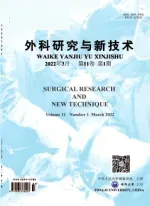Intervention combined surgery for the treatment of acute iliofemoral vein thrombosis
/Li Tianrun
(李天润,Dept Intervent Vascul Surg ,Peking Univ,3rd Hosp,Beijing 100191)…∥Chin J Gen Surg.-2011,26(10).-845~848
ObjectiveTo compare two treatment methods for acute iliofemoral vein thrombosis:catheter-directed pharmacomechanical thrombolysis(CDPT,47 cases)and intervention combined surgical therapy(IST,14 csaes).MethodsThis study includes 61 patients of acute iliofemoral vein thrombosis treated by CDPT or IST.All discharged cases were followed up by telephone for a peruod of 14-37 months.ResultsAmong the 61 patients(64 extremities),47(forty-seven extremities)treated by CDPT,and 14 cases(seventeen extremities)treated by IST.The ISR group included three patients of bilateral iliofemoral vein thrombosis,five patients on postoperative status within one month,and three patients in which the iliofemoral vein was not accessible.When discharged from hospital,the effective rate of edema relief is 93.6%in CDPT group while that is 94.1%in IST group;Melena occurred in one patient of CDPT group and incision hematoma occurred in one patient of IST group.According to the results of CDPT group(x2=0.004 and the p=0.948).Calf pigmentation occcurrd in only one patient of CDPT group.The patency rate of vein by BUSexamination is52.6%in CDPT group while that is 84.6%in IST group(x2=4.157,p=0.041).ConclusionComparing with CDPT group,IST group has the similar effective rate of edema relief,but has higher patency rate of iliofemoral vein.In case of bilateral acute iliofemoral vein thrombosis,in patients in whom thrombolysis is contraindicated,or when the iliofemoral vein is not accessible,IST is the treatment of choice for acute iliofemoral vein thrombosis.6 refs,2 tabs
- 外科研究与新技术的其它文章
- Value of diffusion-weighted MR imaging and dynamic-contrast enhanced MRI in the diagnosis of breast cancer
- Meta-analysis of the efficacy between gemcitabine-alone and gemcitabine-based chemotherapy applied to advanced pancreatic cancer
- Effect of decompression in different time on hemodynamics and oxygen metabolism of porcine model with severe acute pancreatitis combined intraabdominal hypertension
- Postoperative use of Sorafenib in liver transplantation patients of hepatocellular carcinoma beyond Milan criteria
- Combined liver-kidney transplantation and orthotopic liver transplantation in the treatment of severe hepatitis B
- HO-1 up-regulation decreases liver ischemia/reperfusion injury by inhibiting mast cells degranulation

